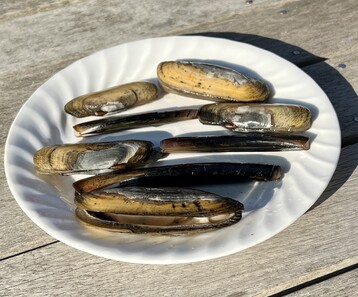Current Nature: Autumn Gold
Seth Engelbourg, Naturalist Educator and Program Manager at the Linda Loring Nature Foundation •

Although the chill in the air is a trade-off, Nantucket’s most celebrated season is finally here! Yesterday, marked the beginning of recreational scallop season, a time-honored tradition loved by residents and visitors of all ages and backgrounds.
Bay scallops can be found from the Massachusetts Bay down to the Gulf of Mexico. As their name suggests, they typically live in shallow, coastal waters and are especially plentiful in protected harbors supporting healthy seagrass meadows. On-island, they can be found both in Nantucket and Madaket harbors, in areas with healthy eelgrass. Compared to other marine bivalves, such as clams, they are short-lived, generally having a lifespan of around two years. On average, quahogs live between 15-20 years and sometimes up to 40. They are also unique from other shellfish due to their ability to swim. Scallops are mobile; they rapidly clap their shells together and forcibly eject water to move about. They also are famous for having eyes, generally 30-40, that line the outer rim of their shells. Although they lack a centralized brain, each eye is complete with a lens, retina, cornea, and optic nerve, enabling the scallop to see movement and shadows. To feed, they filter plankton out of the water column and can effectively remove excess nutrients.

The special treat about Nantucket is that our island’s waters support the last remaining commercially viable bay scallop fishery anywhere in the world. Nantucket bay scallops also tend to be larger and sweeter than ones from other places. Although, the commercial fishery will not start until November, October is your chance to get out on the water and harvest these delicious shellfish yourself. Want to give it a try? The first step is to make sure you have a valid Nantucket Recreational Shellfish Permit. Once you have received that, you will also need some gear. Two typical ways to harvest scallops are pushraking or diving (snorkeling or SCUBA). The Nantucket Shellfish Association has a helpful guide on recreational shellfishing if you have never done it before and are looking for tips. I personally greatly favor diving for scallops rather than pushraking. Although it can take some convincing to submerge yourself in the ocean in October, the proper wetsuit and gear will minimize the chill. The benefit of diving is that in addition to your main objective of collecting scallops, you also get to observe the bounty of life found in our harbors; crabs, fish, whelks, sea stars, and more. As a scientist and nature enthusiast, this makes scalloping truly special, you get to immerse yourself in the scallop’s environment.
Since this is a nature column, not a culinary one, we won’t get too much into what to do with your harvest. Personally, I love making scallop, prosciutto, and arugula pizza, but there are plenty of recipes, cookbooks, and community advice available. Shucking scallops is a learned skill that takes time and effort, but nothing compares with a sea-to-table meal where your scallops are prepared only a few hours after harvesting them.
I hope you enjoy the experience and bounty of shellfishing this fall. Although scallops are the most famous and sought after, Nantucket waters are also home to many other shellfish, which play an important role in our ecosystems and bring joy to harvest. Of note are soft-shell and razor clams.

The season recently reopened for both species, starting on September 15th, and is open only on Sundays. As they say, variety is the spice of life, so I always enjoy spending time each fall searching for these. You will experience different habitats, harvesting techniques, and tastes! Remember in any interaction with nature that involves harvesting, always follow the appropriate regulations and practice good ethics. But most importantly, have fun and enjoy the beauty of fall on Nantucket!
Stay tuned for more editions of Current Nature, a bi-weekly column featuring seasonal topics, natural history information, and advice on the outdoors from the staff at the Linda Loring Nature Foundation.
